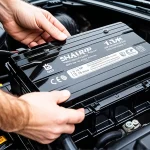Understanding Automatic Emergency Braking Systems
Automatic emergency braking (AEB) is a critical vehicle safety feature designed to minimize collisions by automatically applying the brakes when a potential crash is detected. Modern AEB systems rely on a mix of sensors, including radar, lidar, and cameras, to continuously monitor the vehicle’s surroundings. These sensors work together to assess the speed and distance of objects ahead, identifying imminent collision risks with high accuracy.
The primary function of AEB systems is to detect obstacles such as other vehicles, pedestrians, or cyclists and intervene if the driver does not respond in time. When the system calculates that a collision is likely, it alerts the driver first; if there is still no response, the automatic braking engages to either reduce the impact speed or prevent the accident altogether. This automated intervention dramatically enhances overall vehicle safety by providing a timely reaction that human drivers may be unable to deliver under sudden hazard conditions.
This might interest you : Mastering Vehicle Safety: Key Strategies for Accurate Calibration of Collision Avoidance Technology
There are different types of sensors utilized in AEB systems. Radar sensors use radio waves to measure the distance and relative speed of objects, excelling in various weather and lighting conditions. Cameras provide visual recognition capabilities, allowing the system to distinguish between different obstacles such as pedestrians or vehicles. Lidar, although less common due to cost, offers detailed three-dimensional mapping of the environment, improving detection precision.
Currently, AEB systems are integrated across a wide range of vehicle models, from economy cars to luxury models and large commercial vehicles. This feature is increasingly becoming standard rather than optional, reflecting its importance in enhancing road safety. Manufacturers continuously refine AEB technology, updating software algorithms and sensor calibration to improve its reliability. Understanding how these systems function helps drivers appreciate their role in preventing accidents and encourages their correct usage.
Also to see : Enhancing Lane-Keeping Assist: Tailoring Vehicle Settings for Optimal Performance on Rural UK Roads
Key Benefits and Safety Advantages of AEB
Automatic emergency braking (AEB) offers substantial vehicle accident prevention by actively intervening to reduce or avoid collisions. Numerous studies confirm that vehicles equipped with AEB systems experience fewer rear-end crashes and pedestrian accidents. This is because AEB can react faster than a human driver, applying brakes precisely when a collision risk is detected, thereby lowering the potential severity of impact.
AEB advantages extend beyond just accident reduction. They provide enhanced protection for all road users: drivers, passengers, and pedestrians alike. By automatically mitigating hazards, these systems safeguard vulnerable groups, such as cyclists and pedestrians, who are often involved in serious accidents. Additionally, AEB contributes to safer urban environments by lessening the likelihood of dangerous interactions in crowded traffic or crosswalks.
Insurance companies often recognize the positive impact of AEB on overall road safety. Many offer incentives, such as reduced premiums, for vehicles equipped with reliable AEB features. Industry endorsements also support adoption, highlighting AEB’s role in moving toward safer roads globally.
Ultimately, the integration of AEB into modern vehicles not only improves immediate safety outcomes but encourages a culture of precaution, promoting enhanced road safety for everyone on the road.
Operational Limitations and Important Considerations
Automatic emergency braking (AEB) systems significantly enhance vehicle safety features, but understanding AEB limitations is crucial for responsible use. One key limitation involves weather and lighting impacts; for example, heavy rain, fog, snow, or direct sunlight can impair sensor performance. Radar generally fares better in adverse weather compared to cameras or lidar, but each sensor type may face challenges detecting obstacles accurately under certain conditions.
Systems can also exhibit system constraints such as false positives—where the AEB activates unnecessarily—or failure to recognize some stationary or low-contrast objects. These false activations may cause abrupt braking events, potentially confusing or startling drivers. Recognizing these boundaries helps drivers maintain appropriate vigilance and avoid over-reliance on AEB systems alone.
Manual intervention remains necessary in complex driving environments or unusual scenarios. For instance, when driving through construction zones, on slippery roads, or with abrupt obstacles outside the AEB’s sensing capabilities, drivers must actively control vehicle braking and steering. This highlights the importance of understanding when the system might underperform and keeping hands on the wheel at all times.
In sum, while AEB systems provide valuable automated support, their performance depends heavily on external conditions and sensor accuracy. Being aware of these operational limitations empowers drivers to use AEB safely and effectively alongside their own attentive driving.
Maintenance and Upkeep of Your AEB System
Proper AEB maintenance is vital to ensure that automatic emergency braking systems continue functioning accurately and reliably as part of your vehicle safety features. Regular inspection of AEB sensors—radar, cameras, and lidar—is necessary because dirt, debris, or environmental factors can obstruct sensor fields, leading to reduced detection performance or false alarms. Sensor cleaning should be done carefully, using appropriate materials to avoid damage.
Calibration of sensors is another essential upkeep task. Over time or after collisions or windshield replacements, sensors might misalign, impairing the system’s ability to correctly assess road conditions. Professional servicing is recommended to recalibrate sensors, as precise alignment is critical for accurate object detection and timely intervention.
Software updates are also integral to system care. Vehicle manufacturers periodically release updates that improve AEB algorithms, correct bugs, and enhance system responsiveness. Maintaining up-to-date software ensures your vehicle benefits from the latest advances in AEB technology. Ignoring updates or deferring maintenance can degrade overall AEB reliability, impacting vehicle safety features.
Common malfunctions can include unexpected alerts or system deactivation. Troubleshooting begins with checking sensor cleanliness and confirming that no aftermarket modifications obstruct sensors. Persistent issues should prompt consultation with authorized service centers to diagnose and restore full functionality.
In summary, consistent maintenance—including sensor cleaning, calibration, and software updates—proactively preserves AEB system efficacy. This upkeep not only extends the lifespan of these critical vehicle safety features but also guarantees the system performs as intended, enhancing your safety on the road.
Best Practices for Everyday AEB Usage
Effective AEB usage is vital for maximizing the safety benefits of automatic emergency braking systems while maintaining responsible driving habits. First, always ensure your AEB system is properly enabled and calibrated before starting your journey. Modern vehicles often activate AEB by default, but verifying system status through dashboard indicators or vehicle settings is important for confidence in its readiness.
Monitoring system alerts closely is another key aspect of prudent AEB use. When the system warns of a potential collision or activates braking, respond promptly by maintaining control of the vehicle and preparing to take over if necessary. These alerts serve as critical cues to supplement your awareness, not replace attentive driving. Ignoring or misinterpreting alerts reduces the system’s effectiveness and may increase accident risk.
Integrating AEB with defensive driving techniques further amplifies safety. Maintain appropriate following distances, obey speed limits, and anticipate road hazards to assist the system’s timely detection and intervention. Automatic emergency braking should be viewed as an enhancement, not a substitute, for proactive driving habits that emphasize hazard anticipation and smooth vehicle control.
In summary, the best practices for everyday AEB usage involve confirming system readiness, attentively responding to system signals, and driving defensively. This combination ensures that vehicle safety features like AEB provide optimal protection while encouraging safe and responsible road behavior.
Essential Safety Recommendations and Actionable Steps
To ensure optimal AEB performance, drivers should follow established AEB safety guidelines consistently. First, confirm that the automatic emergency braking system is fully operational before driving. This involves checking dashboard indicators and ensuring no sensor obstructions such as dirt or ice. Regularly cleaning AEB sensors is a foundational maintenance step that directly impacts system accuracy.
A practical user checklist includes:
- Verifying system activation and status
- Maintaining clear sensor visibility by removing dirt, snow, or debris
- Monitoring system alerts attentively during driving
- Responding promptly to warnings or automatic braking events
Recognizing that AEB systems complement but do not replace active driving control is crucial. Users bear responsibility for remaining vigilant and prepared to intervene manually if the system limits are reached, such as in poor weather or unexpected road hazards.
Common user questions often focus on system responsiveness and reliability. For example, “Can AEB operate effectively in heavy rain?” The precise answer is that while AEB sensors, particularly radar, perform reasonably well in rain, camera and lidar sensors may be less effective, requiring increased driver caution.
By adhering to these actionable safety tips and maintaining awareness of system capabilities, drivers maximize the benefits of automatic emergency braking as a vital vehicle safety feature that supports—but does not substitute—safe driving practices.











